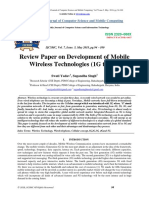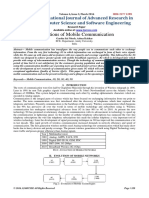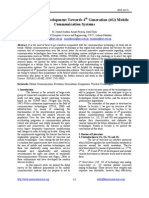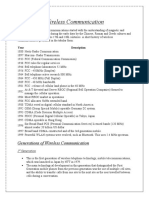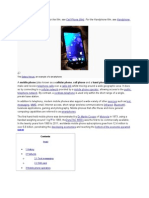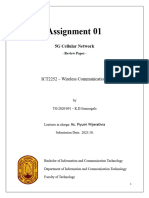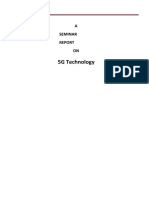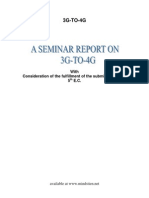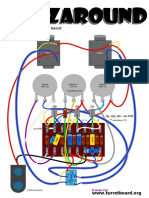INDEX.
SR. CONTENT PAGE
NO. NO.
1 INTRODUCTION 1
2 COURSE OUTCOMES 2
3 LITERATURE REVIEW 3
4 HISTORY 5
5 FEATURES OF 10
MOBILE
TECHNOLOGY
6 CONCLUSION 15
7 REFERENCES 16
�MOBILE GENERATIONS
Introduction to Mobile communication generations
1. INTRODUCTION
Any recent changes in the mobile telephone communication setup have been termed as generations. The
changes in mobile Telephony that includes the systems, functions, characteristics, and interconnections
required to create an electronic network that allows a telecommunications network operator to provide
services are called the mobile communication generations. In a mobile communications system, data
transmission and reception, information routing and data management are aspects of mobile telephony.
A mobile phone (cellphone, etc.)[a] is a portable telephone that can make and receive calls over a radio
frequency link while the user is moving within a telephone service area, as opposed to a fixed- location phone
(landline phone). The radio frequency link establishes a connection to the switching systems of a mobile
phone operator, which provides access to the public switched telephone network (PSTN). Modern mobile
telephone services use a cellular network architecture and therefore mobile telephones are called cellphones
(or "cell phones") in North America. In addition to telephony, digital mobile phones support a variety of other
services, such as text messaging, multimedia messagIng, email, Internet access (via LTE, 5G NR or Wi-Fi),
short-range wireless communications (infrared, Bluetooth), satellite access (navigation, messaging
connectivity), business applications, video games and digital photography. Mobile phones offering only basic
capabilities are known as feature phones; mobile phones which offer greatly advanced computing capabilities
are referred to as smartphones.[1]
The first handheld mobile phone was demonstrated by Martin Cooper of Motorola in New York City on 3 April
1973, using a handset weighing c. 2 kilograms (4.4 lbs).[2] In 1979, Nippon Telegraph and Telephone (NTT)
launched the world's first cellular network in Japan.[3] In 1983, the DynaTAC 8000x was the first commercially
available handheld mobile phone. From 1983 to 2014, worldwide mobile phone subscriptions grew to over
seven billion; enough to provide one for every person on Earth.[4] In the first quarter of 2016, the top
smartphone developers worldwide were Samsung, Apple and Huawei; smartphone sales represented 78
percent of total mobile phone sales.[5] For feature phones (slang: "dumbphones") as of 2016, the top-selling
brands were Samsung, Nokia and Alcatel.[6]
Mobile phones are considered an important human invention as it has been one of the most widely used and
sold pieces of consumer technology.[7] The growth in popularity has been rapid in some places, for example
in the UK the total number of mobile phones overtook the number of houses in 1999.[8] Today mobile phones
are globally ubiquitous,[9] and in almost half the world's countries, over 90% of the population own at least
one.
1
�MOBILE GENERATIONS
2. COURSE OUTCOME
• Mobile communication has transfigure the way people use to communicate each other to exchange
information.
• From the very first technology 1G in which information was exchanged in form of basic voice signals
• The 2G came up with many add on features with new capacity and coverage capability.
• The 3G which was designed to achieve greater speeds with mobile broadband experience.
• 4G which is developed later which provide wide range of telecommunication services.
• This lead to the development of new research of communication given name 5G which willcome up with
much greater speed, exceptional applications, Quality of Service (QoS).
2
�MOBILE GENERATIONS
3. LITERATURE REVIEW:
link:http://shodh.inflibnet.ac.in:8080/jspui/bitstream/123456789/4851/3/03_review%20of%20literatu re.pdf
Kumar Amit et. al. (2010), - Mobile communications systems revolutionized the way people
communicate, joining together communications and mobility. A long way in a remarkably short time
has been achieved in the history of wireless. Evolution of wireless access technologies is about to reach
its fourth generation (4G). Looking past, wireless access technologies have followed different
evolutionary paths aimed at unified target: performance and efficie ncy in high mobile environment.
The first generation (1G) has fulfilled the basic mobile voice, while the second generation (2G) has
introduced capacity and coverage. This is followed by the third generation (3G), which has quest for
data at higher speeds to open the gates for truly “mobile broadband” experience, which wil be further
realized by the fourth generation (4G). The Fourth generation (4G) will provide access to wide range of
telecommunication services, including advanced mobile services, supported by mobile and fixed
networks, which are increasingly packet based, along with a support for low to high mobility
applications and wide range of data rates, in accordance with service demands in multiuser
environment. This paper provides a high level overview of the evolution of Mobile Wireless
Communication Networks from 1G to 4G. Ghassan A. Abed, Ismail Mahamod and Jumari Kasmiran.
(2012), - The era of new wireless communications is upon us. Eventually it will penetrate into our daily
life and change the way we live just like many technological innovations who’s original. research came
from the life needs. To achieve these requirements, the society of 3rd Generation Partnership Project
(3GPP) is presently evolving Long Term Evolution Advanced (LTE Advanced) as a development of the
standard of LTE. The goal of this generation is to produce specifications for a new radio-access
technology geared to higher data rates, low latency and greater spectral efficiency
https://www.semanticscholar.org/paper/A-survey-of-platforms-for-mobile-networks-research-
Oliver/74c5df18362856bebe87c9190b3e0bf6e4bd3b73
The contribution of this study is to highlight some new and unique specifications/features in the mobile
phones that are not much expensive and can attract different types of users having different life status
and education level.
The most corporate and finest way of communication is mobile phones. Mobile phones are under
development up till now. Various enterprises try to offer different and unique type of specification/features
3
�MOBILE GENERATIONS
to entice the users. Now a day almost every single mobile phone has common specifications like power
bank, SIM card, text messaging (SMS), multimedia messaging (MMS), Internet, Bluetooth, Games, touch
screen etc. A few of them are light weight while others are heavy weight, similarly with the size. In this paper
different generations of mobile phones as well as proportional study of mobile operating systems are done.
The contribution of this study is to highlight some new and unique specifications/features in the mobile
phones that are not much expensive and can attract different types of users having different life status and
education level as well. Collapse.
https://justaskthales.com/en/generations-mobile-networks-explained/
First generation mobile networks were reliant upon analogue radio systems which meant that users could only
make phone calls, they couldn’t send or receive text messages. The 1G network was first introduced in Japan in
1979 before it was rolled out in other countries such as the USA in 1980. In order to make it work, cell towers
were built around the country which meant that signal coverage could be obtained from greater distances.
However, the network was unreliable and had some security issues. For instance, cell coverage would often
drop, it would experience interference by other radio signals and due to a lack of encryption, it could easily be
hacked. This means that with a few tools, conversations could be heard and recorded.The 1G network was not
perfect, but it remained until remained until 1991 when it was replaced with 2G. This new mobile network ran
on digital signal, not analogue, which vastly improved its security but also its capacity. On 2G, users could send
SMS and MMS messages (although slowly and often without success) and when GPRS was introduced in 1997,
users could receive and send emails on the move.Third generation mobile networks are still in use today, but
normally when the superior 4G signal fails. 3G revolutionised mobile connectivity and the capabilities of cell-
phones. In comparison to 2G, 3G was much faster and could transmit greater amounts of data. This means that
users could video call, share files, surf the internet, watch TV online and play online games on their mobiles for
the first time. Under 3G, cell-phones where no longer just about calling and texting, they were the hub of social
connectivity.
https://www.researchgate.net/publication/356776158_A_Literature_Review_On_Wireless_Technologi
es_From_0G_to_7G
Wireless technology is evolving in all areas of mobile and wireless communications and it is one of the fastest
growing sectors. In the last decade, there has been a huge increase in wireless technology. The evolution of
wireless technology now a day has been reached at 7.5 Generation (G). This paper focus on the literature
survey to discuss the most popular wireless technologies with their features of several generations which are
being commonly consider as 0G,1G, 2G, 3G, 4G, 5G, 6G & 7G. We focus on the evolution and development of
different generations of mobile wireless technology and their importance and benefits among others.
4. HISTORY:
Main article: History of mobile phones Martin Cooper of Motorola, shown here in a 2007 reenactment, made
the first publicized handheld mobile phone call on a prototype DynaTAC model on 3 April 1973.
4
�MOBILE GENERATIONS
A handheld mobile radio telephone service was envisioned in the early stages of radio engineering. In 1917,
Finnish inventor Eric Tigerstedt filed a patent for a "pocket-size folding telephone with a very thin carbon
microphone". Early predecessors of cellular phones included analog radio communications from ships and
trains. The race to create truly portable telephone devices began after World War II, with developments
taking place in many countries. The advances in mobile telephony have been traced in successive
"generations", starting with the early zeroth- generation (0G) services, such as Bell System's Mobile Telephone
Service and its successor, the Improved Mobile Telephone Service. These 0G systems were not cellular,
supported few simultaneous calls, and were very expensive.
The Motorola DynaTAC 8000X. In 1983, it became the first commercially available handheld cellular mobile
phone.The first handheld cellular mobile phone was demonstrated by John F. Mitchell[11][12] and Martin
Cooper of Motorola in 1973, using a handset weighing 2 kilograms (4.4 lb).[2] The first commercial automated
cellular network (1G) analog was launched in Japan by N ippon Telegraph and Telephone in 1979. This was
followed in 1981 by the simultaneous launch of the Nordic Mobile Telephone (NMT) system in Denmark,
Finland, Norway, and Sweden.[13] Several other countries then followed in the early to mid-1980s. These
first-generation (1G) systems could support far more simultaneous calls but still used analog cellular
technology. In 1983, the DynaTAC 8000x was the first commercially available handheld mobile phone.
In 1991, the second-generation (2G) digital cellular technology was launched in Finland by Radiolinja on the
GSM standard. This sparked competition in the sector as the new operators challenged the incumbent 1G
network operators. The GSM standard is a European initiative expressed at the CEPT ("Conférence
5
�MOBILE GENERATIONS
Européenne des Postes et Telecommunications", European Postal and Telecommunications conference). The
Franco-German R&D cooperation demonstrated the technical feasibility, and in 1987 a Memorandum of
Understanding was signed between 13 European countries who agreed to launch a commercial service by
1991. The first version of the GSM (=2G) standard had 6,000 pages. The IEEE and RSE awarded to Thomas
Haug and Philippe Dupuis the 2018 James Clerk
Maxwell medal for their contributions to the first digital mobile telephone standard.[14] In 2018, the GSM
was used by over 5 billion people in over 220 countries. The GSM (2G) has evolved into 3G, 4G and 5G. The
standardisation body for GSM started at the CEPT Working Group GSM (Group Special Mobile) in 1982 under
the umbrella of CEPT. In 1988, ETSI was established and all CEPT standardization activities were transferred to
ETSI. Working Group GSM became Technical Committee GSM. In 1991, it became Technical Committee SMG
(Special Mobile Group) when ETSI tasked the committee with UMTS (3G).
Dupuis and Haug during a GSM meeting in Belgium, April 1992
Personal Handy-phone System mobiles and modems, 1997–2003
In 2001, the third generation (3G) was launched in Japan by NTT DoCoMo on the WCDMA standard.[15] This
was followed by 3.5G, 3G+ or turbo 3G enhancements based on the high-speed packet access (HSPA) family,
allowing UMTS networks to have higher data transfer speeds and capacity.
By 2009, it had become clear that, at some point, 3G networks would be overwhelmed by the growth of
bandwidth- intensive applications, such as streaming media.[16] Consequently, the industry began looking to
data-optimized fourth-generation technologies, with the promise of speed improvements up to ten-fold over
existing 3G technologies. The first two commercially available technologies billed as 4G were the WiMAX
standard, offered in North America by Sprint, and the LTE standard, first offered in Scandinavia by
TeliaSonera.
5G is a technology and term used in research papers and projects to denote the next major phase in mobile
telecommunication standards beyond the 4G/IMT-Advanced standards. The term 5G is not officially used in
any specification or official document yet made public by telecommunication companies or standardization
bodies such as 3GPP, WiMAX Forum or ITU-R. New standards beyond 4G are currently being developed by
standardization bodies, but they are at this time seen as under the 4G umbrella, not for a new mobile
generation.
First Generation (1G) Technology
In this generation of technology, mobile communication is done only through an analog signal that has been
used to transmit the user data. The wireless industry has gone through a phase of digitization in which many
of the devices that users today use with a wired PC connect to the Internet. 1G technology was primarily used
and designed for voice communication purposes. The US Army began using VoIP (Voice over IP) technology in
the late 1980s to create a new way of communication for soldiers in wartime, and this first generation of VOIP
systems could be considered a breakthrough in the field of communications. However, these systems were
6
�MOBILE GENERATIONS
not practical as many voice calls were not available, including government communications. It is an analog
voice communication s ystem consisting of two microphones, an amplifier, and a signal generator/modulator,
called Voice Over Internet Protocol. This method of data transmission enables communication with any other
device by using only the telephone line. When the user connects his device via the telephone, he will be
connected to the other person over the telephone line. That connection provides both parties with the same
information. So, the receiver and transmitter share the information.
Second Generation (2G) Technology
The first time the digital signal was used in mobile telephony to transmit signals was in the second generation
era of mobile communication. Mobile phones in this generation were capable of transmitting audio and video.
The technology was used in more than 60 countries and is already well established in North America and
Europe. 2G in a way revolutionized the mobile communication industry although the network speed is limited
to 64kbps lots of digital information was being shared.
GPRS technology was introduced it became very useful in transmitting more data through email and other
web services that use slightly more network speed. The text message SMS feature in 2G technology was
widely used and extremely popular at that time and it allowed many users to occup y a frequency band which
made it more efficient.
Third Generation (3G) Technology
In this technology true revolution took place where the network speed was increased up to 2Mpbs which
made high-speed browsing, gaming, email, and other web services possible to a vast segment of the
population. 3G technology has made a scenario where new mobile phones are developed and sold with major
advertising capabilities. This makes the users a core demographic and is very important for the mobile service
provider. Since all the existing mobile networks now have to run the latest operating systems and hardware,
the number of mobile phones has increased from about 600 million in 1998 to nearly 10 billion today. This
huge number of mobile phones is changing the face of telecommunications. Today, the mobile operator only
has to sell one million smartphones in a year or one percent of the total sales in the mobile industry. This
created some downside to the technology where the infrastructure setup for mobile towers and services
became high and mobile phones became costly where a most segment of the population couldn’t afford to
buy.
Fourth Generation (4G) Technology
After the 3G transition, the next evolution took place with the introduction of mobile broadband and mobile
data in the year 2011 where 4G was introduced. 4G was one step higher than the 3G which was considered a
revolution. With 4G, carriers can create a “super high speed” network so that even at 2G speeds it’ll be able to
deliver fast, reliable downloads in just 30 seconds. The network speed in 4G has been increased up to 100Mpbs.
This technology made possible some of the things such as high- speed gaming, High-definition Mobile Television,
Digital Streaming, HD Television services, Cloud computing, etc. 4G offers faster data speeds at lower prices, in
areas that are underserved by its competitors, and offers a wider variety of cellular networks. The development
of Smartphones became very popular after the launching of 4G where all the devices manufactured post-2013
supported the 4G feature which made 4G technology reach a wider audience. The 4G technology is being
7
�MOBILE GENERATIONS
increasingly rolled out in 3G and 3G-LTE networks. As the technology matures, the number of devices and
applications to support 4G growth will increase dramatically, from roughly 100 million devices today to over 1.5
billion devices in 2020.
4G offers a lot of capabilities features to the users such as Advanced user capabilities like multitasking, rich
content browsing, and instant calling. A new type of multimedia access with Wi-Fi. A new way to upload
photos and videos directly from their memory. Ability to share and view online content with friends. Ability to
transfer content from the mobile device and use it on the go, etc.
Fifth Generation (5G) Technology
The wireless evolution of 5G is solving the problem of resource allocation by means of cooperation and
coordination. Basically, 5G is the standard of wireless cellular technology, which was developed by 3GPP. The
5G is following footsteps of the 3G and 4G technologies. 5G network is based on the standards which was
connecting wireless routers, smartphones, and other communication devices. 5G is delivering a good
improvement in latency, transmission speed, and flexible deployment. 5G delivers additional capabilities as
compared to the 4G wireless network. The below figure shows how revolution is done from 2G to 5G network.
8
�MOBILE GENERATIONS
5. FEATURES OF MOBILE GENERATION :
• The most-discussed 5G feature is increased speed and bandwidth. With a data rate of up to 10 Gbps, 5G
will bring a 10 times to 100 times improvement over the existing 4G LTE technology. Cellular is now a
potential technology for branch office automation because WAN connections finally have enough
bandwidth. For businesses, the real benefit of 5G might not be the actual bandwidth, but the pressure that
5G exerts on market prices of incumbent WAN connectivity.
• 5G's low latency, under 5 milliseconds, is the other key benefit for WAN usage. Customers are using
MPLS or dedicated lines today primarily for low latency in line-of-business applications. 5G's low
latency may bring additional flexibility that lets businesses jettison some of their branch office
MPLS infrastructure in favor of the less expensive and more flexible 5G connections to branches.
This is especially true in retail or shared infrastructure or very remote environments.
• 5G density enables up to 100 times more connected devices in the same physical area that 4GLTE operates
today, while maintaining 99.999% availability. While this density may bring business advantages for mobile
workforces, the real benefit is increasing the size of the mobile customer market. Mobile e-commerce is
growing faster than retail and traditional computer- based e- commerce. More customers than ever use
mobile technologies to shop online, so greater density increases the overall addressable market.
• An estimated 90% reduction in power consumption for devices means minor power savings at the
smartphone level. But, from an infrastructure perspective, especially for IoT devices, the power savings
could be significant. Combining IoT devices with a cellular 5G communicationmeans lower power overhead
in design and actual consumption. Remote devices can be expected to last significantly longer when
9
�MOBILE GENERATIONS
running on battery alone. Some estimates even showthat a 10-year remote battery life may be achievable
for IoT-based sensor devices deployed inremote locations.
• Security is always a concern for mobile devices and IoT devices because the latter live on theedge of the
corporate network. With 5G, stronger security than 4G LTE is available for designers, including hardware
security modules, key management services, over the air, secure element and others. This will help ensure
that the data transmitted over the 5G network is secure while also hardening network endpoints.
Features of 5G technology:
AI/ML and 5G are a perfect match sharing a mutually beneficial relationship. While 5G offers very high speeds
for enhanced mobile broadband (eMBB), support for a massive number of devices (mMTC), and ultra-reliable
low latency communications (URLLC). AI/ML complements the technology by learning from complex patterns to
provide scope for autonomous network operations, transforming 5G into a scalable real-time network that is
data-driven. To optimize performance, AI/ML is used across all layers -- from disaggregated radio access
networks (RAN), to integrated access backhauls (IAB), to the distributed cloud layer (Edge/Core). Just as AI/ML is
useful for 5G network operations, 5G is useful for AI/ML by providing multiple points of presence for data
collection & computing, control loops that can operate in multiple time scales to support distributed
intelligence, deployment automation, and orchestration for the life cycle management of models.
In this webinar, we will cover the role of AI/ML to support data-driven 5G operations to include slice
management, fault prediction, security, the interplay of AI/ML with edge computing, how AI/ML is being
leveraged for O-RAN, and opportunities for autonomous network operations. We will also share progress being
made in the IEEE Future Networks Initiative's AI/ML working group, and the roadmap items being considered for
5G and beyond networks.
This webinar is a collaboration between IEEE Digital Reality and IEEE Future Networks. Future Networks
dedicates an entire chapter to AI/ML in their roadmap project, the INGR (International Network Generations
Roadmap).
Features of 4G technology:
Better download speed
Extremely high voice quality.
10
�MOBILE GENERATIONS
Easy access to Internet, IM, social networks, streaming media, video calling. Higher
bandwidth.
Much faster than 3G
The Fourth Generation (4G) of broadband cellular network technology is based on the capabilities defined by
the ITU(International Telecommunication Union) in IMT Advanced (International Mobile Telecommunications
Advanced) which supersede the 3G. It is popularly referred to as MAGIC, which is the acronym for “Mobile
multimedia, Any-where, Global mobility solutions over, Integrated wireless and Customized services.” According
to the ITU, a 4G network requires a mobile device to be able to exchange data at 100 Mbps for high mobility
communication and 1 Gbps for low mobility communication. Potential and current applications include
amended mobile web access, IP telephony, gaming services, highdefinition mobile TV, video conferencing, 3D
television.
4G is much faster than 3G, and this has revolutionised the field of telecommunication by bringing the wireless
experience to a new level altogether. 4G systems support interactive multimedia, voice, video, wireless internet
and other broadband services. Technologically, 4G is very different compared to 3G.
Global 5G Adoption in 2022 :
11
�MOBILE GENERATIONS
The Future of 5G :
12
�MOBILE GENERATIONS
The future of 5G, the fifth generation of wireless communication technology, holds great
promise for transforming various industries and aspects of our daily lives. Here are some potential
trends and developments that could shape the future of 5G:
Massive Internet of Things (IoT) Connectivity : 5G is expected to provide the infrastructure for
connecting billions of devices, creating a vast network of interconnected devices and sensors,
known as the Internet of Things (IoT). This could enable advancements in areas such as smart
cities, smart homes, smart industries, and autonomous vehicles, where devices and systems can
communicate and share data in real-time, leading to increased efficiency and improved quality of
life.
Enhanced Mobile Broadband (eMBB) : 5G is set to offer significantly faster download and upload
speeds compared to previous generations of wireless technology. This could enable high-quality
streaming of 4K and 8K video content, virtual reality (VR), augmented reality (AR), and other data-
intensive applications on mobile devices, making mobile experiences more immersive and
seamless.
Edge Computing : 5G's low-latency capabilities could drive the adoption of edge computing, where
data processing and storage are moved closer to the end users, reducing the need for data to
travel back and forth to centralized data centers. This could lead to faster response times for
critical applications such as autonomous vehicles, remote healthcare, and industrial automation.
Industry 4.0 : 5G is expected to revolutionize industries such as manufacturing, logistics, and
agriculture by enabling advanced applications like smart factories, autonomous drones for crop
monitoring, and remote management of industrial processes. The low-latency and high- reliability
features of 5G could unlock new levels of automation, efficiency, and productivity, leading to the
concept of Industry 4.0, which refers to the fourth industrial revolution driven by digitalization and
connectivity.
Enhanced Connectivity in Rural and Remote Areas : 5G has the potential to bring high- speed
internet access to rural and remote areas, bridging the digital divide and enabling access to
information, education, and economic opportunities for underserved populations.
Network Slicing : 5G's network slicing capability allows for the creation of virtual networks that
can be customized for specific use cases or industries, offering tailored connectivity solutions with
different performance characteristics such as latency, bandwidth, and reliability. This could enable
new business models, service offerings, and monetization opportunities for network operators.
Security and Privacy Challenges : As 5G networks become more pervasive and interconnected,
addressing security and privacy concerns will be critical. 5G networks will need to have robust
security measures in place to protect against cyber threats, data breaches, and privacy violations.
Regulatory and Spectrum Challenges : The deployment of 5G networks requires access to
sufficient radio frequency (RF) spectrum, which is a limited and valuable resource. Managing
spectrum allocation and interference issues, and addressing regulatory challenges related to 5G
13
�MOBILE GENERATIONS
deployment, such as infrastructure deployment and local regulations, will be crucial for the
successful rollout of 5G networks.
Social and Ethical Considerations : The widespread adoption of 5G will raise social and ethical
considerations, such as the impact on employment, privacy, equity, and ethics of AI- powered
applications. Addressing these concerns and ensuring that 5G is deployed in a responsible and
inclusive manner will be important for its long-term success.
The future of 5G is bright and holds great potential for transforming various industries and aspects
of our daily lives. With faster speeds, low latency, massive IoT connectivity, edge computing, and
other advanced features, 5G is expected to enable new services, business models, and applications
that could reshape industries, enhance user experiences, and drive economic growth. However,
addressing challenges.
6. CONCLUSION
14
�MOBILE GENERATIONS
Wireless communications globally is something that people can expect as technology advances. Wireless
communications has a lot of benefits and can make the world a lot more efficient. It does have concerns
though as with every other new advancement that is made in today’s world. The issues with security
regarding access to a person’s personal information or the negative impact that it may seem to have on
society are a few things that are holding back the progress that wireless technology could be making. With
more research and experiments conducted, the problems associated with wireless communications can be
reduced and make it a more significant part of the world. Wireless technology will be very important in the
near future where the need for wires connecting individual devices seems to be coming to an end.
7. REFERENCES:
1) https://www.educba.com/mobile-communication-generations/
2) https://www.pcmag.com/encyclopedia/term/cellular-generations
15
�MOBILE GENERATIONS
3) link:http://shodh.inflibnet.ac.in:8080/jspui/bitstream/123456789/4851/3/03_review%20of%20literat
ure.pdf
4) video link:https://www.youtube.com/watch?v=f3e1CoqQ9J0
5) https://www.avnet.com/wps/portal/abacus/resources/article/the-evolution-of-cellular-networks/
6) https://www.cengn.ca/information-centre/innovation/timeline- from-1g-to-5g-a-brief-history-on- cell-
phones/
16





















